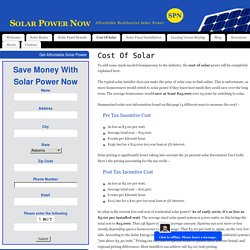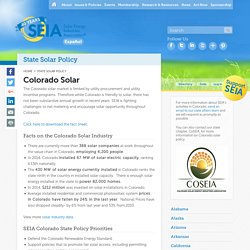

Solar calculator solar panels calculator solar energy payback calculator. Tri-State Generation and Transmission Association, Inc. Tri-State, member co-ops to participate in consumer energy saving campaign Joining nearly 700 other Touchstone Energy Cooperatives from across the country, Tri-State Generation and Transmission Association and its member system co-ops are combining forces to launch a revolutionary national energy efficiency campaign designed to inspire consumers to save energy and money.

This week’s debut of the integrated communications and education campaign, “Together We Save,” features the simultaneous roll-out of television and radio messages, print ads, brochures and related collateral, as well as more than a dozen energy efficiency interactive Web applications linked to a virtual home tour (at www.togetherwesave.com) - all designed to encourage electric co-op member-consumers to take immediate energy saving actions. said Jim Bausell, chief operating officer of Touchstone Energy.
View television commercials and listen to radio commercials from the "Together We Save" campaign. Solar Power Now. To add some much needed transparency to the industry, the cost of solar power will be completely explained here.

The typical solar installer does not make the price of solar easy to find online. This is unfortunate, as more homeowners would switch to solar power if they knew how much they could save over the long term. The average homeowner would save at least $25,000 over 25 years by switching to solar. Summarized solar cost information found on this page (4 different ways to measure the cost) – Pre Tax Incentive CostAs low as $3.00 per watt.Average total cost – $15,000.8 cents per kilowatt hour.$159/mo for a $15,000 ten year loan at 5% interest. Solar pricing is significantly lower taking into account the 30 percent solar Investment Tax Credit. Post Tax Incentive CostAs low as $2.00 per watt.Average total cost – $10,500.6 cents per kilowatt hour.$111/mo for a $10,500 ten year loan at 5% interest. So what is the current low-end cost of residential solar power? 1. Colorado Solar. The Colorado solar market is limited by utility procurement and utility incentive programs.

Therefore while Colorado is friendly to solar, there has not been substantive annual growth in recent years. SEIA is fighting challenges to net metering and encourage solar opportunity throughout Colorado. Click here to download the fact sheet. Facts on the Colorado Solar Industry There are currently more than 388 solar companies at work throughout the value chain in Colorado, employing 4,200 people.In 2014, Colorado installed 67 MW of solar electric capacity, ranking it 13th nationally.The 430 MW of solar energy currently installed in Colorado ranks the state ninth in the country in installed solar capacity. Solar Ready Vets. The SunShot Initiative's Solar Ready Vets program connects our nation’s skilled veterans to the solar energy industry, preparing them for careers as solar photovoltaic (PV) system installers, sales representatives, system inspectors, and other solar-related occupations.

Solar Ready Vets is enabled by the U.S. Department of Defense’s SkillBridge initiative, which allows exiting military personnel to pursue civilian job training, employment skills training, apprenticeships, and internships up to six months prior to their separation. Employment in the U.S. solar industry increased nearly 86% over the past four years, and veterans are strong candidates to fill these positions because they are disciplined, motivated, and technically savvy. The SunShot Initiative’s role in Solar Ready Vets is to build the training capacity for our 400 training institutions, then to create the relationships between the training institutions, the military branch and installations, and solar employers. SunShot Initiative. Solar Energy Resource Center. Quiz: Test Your Solar IQ. How Solar PV is Winning Over CSP - Renewable Energy World.
More and more, renewable energies are competing against each other, instead of against conventional energy sources.

If you read the reports from major energy agencies and industry associations, you might be tempted to conclude that there is a bright future where all types of renewable energies will flourish and coexist peacefully. Well, they will not. Much like in any other sector, some technologies will trump others. In this article, we analyze how solar photovoltaic (PV) is winning over concentrated solar power (CSP). In the 1980s, CSP seemed set to beat solar PV.
Exhibit 1 - The 354-MW SEGS CSP plant, built from 1984 to 1990 in California’s Mojave Desert Exhibit 2 - The 2-MW SMUDPV solar PV plant, built in 1984 in Sacramento, the largest at the time Twenty-five years later, the face of solar energy has changed dramatically. Exhibit 3 - Evolution of PV and CSP global installed capacity (MW) Market size: PV can be installed almost everywhere CSP can, but not the other way around.